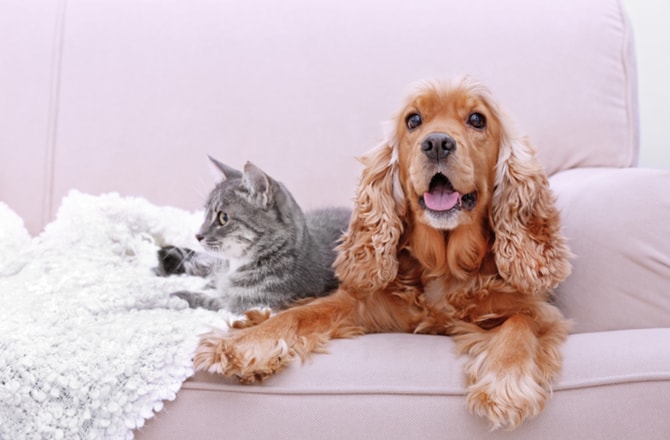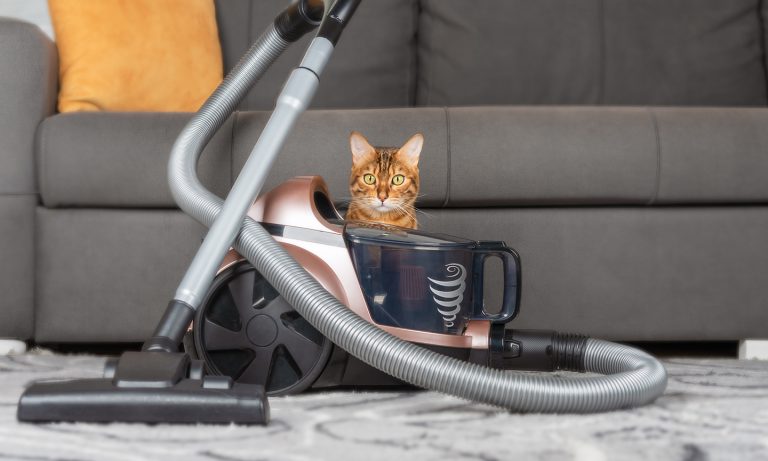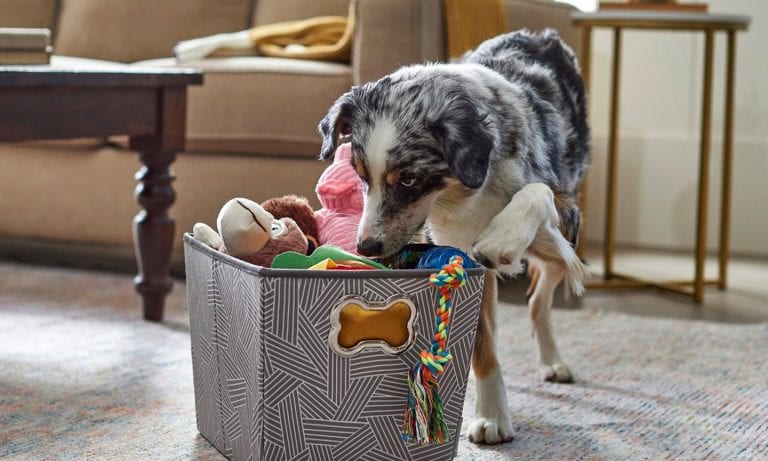One of the challenges of pet parenting is the mess our furry friends can make of our homes. Sometimes I’ll peruse design blogs featuring gleaming, sparse, Scandinavian living rooms, and think, I should decorate like that. Then I’m confronted by reality: free-floating dog hair, kibble sprinkled over the carpet and the aroma of eau de canine. While it’s important to be realistic about living with pets (i.e. you’ll probably never achieve that picture-perfect home), it’s also important to be clean, as much of a hassle as that sometimes presents.
According to Dr. Mary Beth Leininger, DVM and former president of the American Veterinary Medical Association, cleaning is crucial for our pets’ health andour own. Because pets live in such close proximity to our family members, she says, it’s important to be careful about making sure they’re clean.
With this in mind, here are eight ways to be a cleaner pet parent, and why it matters:
Bathe Your Dog Monthly, Your Cat When Necessary

First things first: it’s hard to keep your house clean if your pet is dirty, and having a dirty pet can even be a threat to your health. A 2013 study conducted by scientists at North Carolina State University concluded that homes with pets, particularly dogs, contained a higher level of bacteria than those without. While most of this bacteria is not dangerous to humans, some – like salmonella and listeria – can cause infections in people.
So, dogs need baths, no matter how much they may protest. But how often is it really necessary? Leininger says that once a month is a good bet, but it depends on the dog. “Dogs that are outdoors and running through mud are likely to need baths more frequently,” she says, since much of the bacteria in your home comes in from outdoors.
And what about cats, who “bathe” themselves daily? “Cats and baths are not a good match very often,” Leininger says, however, as they age, they might not keep the same high standards of self-grooming that they used to and may require bathing to keep their skin and coat healthy. Observe your cat, their smell and their coat to get a sense of their hygiene level, and wipe their paws if they spend time outdoors.
When bathing a cat, never use a sprayer. Instead, you’ll need two people – one to gently pour and the other to wrangle – and a tub with a towel at the bottom for the cat to grip.
Groom Your Pet at Least Once a Week

It might surprise some to learn that grooming is as essential as bathing your pet. In addition to keeping your pet (and home) clean, it strengthens the owner-pet bond and alerts you to potential health problems, Leininger says.
“You may find an injury that you hadn’t noticed before, [or] there may be a lump or bump that had never been there before,” she adds.
Grooming is easy to work into the routine – when you find yourself petting or snuggling with your pet, just grab a brush. Leininger recommends grooming weekly, checking in pets’ ears and mouths and cleaning their teeth if possible. Some longhaired breeds, like Persian cats and Afghan hounds, are higher maintenance and need a daily groom to prevent matting. But there’s another bonus: “The more frequently you groom your pets, the less hair you’ll have flying around,” she says.
Master the Art of Pet Hair Removal

Even with regular grooming, pet hair is a huge issue for pet owners. According to the Asthma and Allergy Foundation of America, pet hair is a carrier of allergens such as dander, saliva, urine, dust and pollen. An abundance of these can cause allergies to develop and can exacerbate asthma.
So how to manage the mountains of fluff? Leslie Reichert, green cleaning coach and author of The Joy of Green Cleaning, recommends a robotic vacuum, like a bobsweep or Roomba, to make daily vacuuming less of a chore. “I can schedule it to come on and clean during the night,” she says, adding that “it keeps the pet hair to a minimum.”
For hard flooring, she uses a microfiber mop, which traps hair without cleaning solution. And what about the toughest job – getting pet hair off of furniture?
“You can use a rubber glove and just wipe it over the fabric,” Reichert says. “The static created will lift the hair off. It there’s a lot of hair, it will pull it to the end of the cushion and then you can wipe it off with a damp microfiber cloth.” This quick-and-easy strategy also works on carpeted stairs.
Wash Pet Bedding Regularly

Cleaning your own furniture is a start, but you also need to clean your pet’s bedding. The same bacteria that your dog or cat tracks in from outside is easily transferred to their bedding, and it can cause infections in pets or humans. Bedding is also a magnet for pet dander. To minimize the health risks, Reichert suggests buying washable bedding (many beds come with a removable cover) and cleaning it as frequently as once a week, especially if your pet spends a lot of time outdoors. Cloth toys can be tossed into the same load.
“I treat it just as I would treat my own bedding,” Leininger says. “Use regular laundry detergent, but make sure – and this is important – that it is very, very well rinsed.” This is because, she says, certain detergents can be toxic to pets, who might ingest soap residue left on their beds or toys. Look for very mild or non-toxic detergents, and double-rinse if necessary.
Keep Pet Food Fresh and Carefully Stored

Being a clean pet parent extends to the kitchen as well. Leininger recommends storing food in a clean glass jar that is sealed closed, while Reichert prefers a metal container with a lid stored in a dry, dark environment. These methods will keep food fresh, sealed off from bacteria and won’t attract rodents.
Just as with people-food, always check to make sure pet food is fresh before dishing it out. The ASPCA warns that consuming moldy food can cause serious health issues in pets, such as vomiting, diarrhea, seizures and muscle tremors. Buy enough food for about one month, Leininger says, and keep it sealed.
It’s also important to always wash your hands before feeding your pet, to avoid the potential spread of salmonella or other harmful bacteria.
Buy Bowls That are Easy to Clean – and Clean Them Often

There’s no way around this one: you need to be washing your pets’ dishes more often. According to the FDA, the bacteria in pets’ saliva can multiply in dishes that aren’t regularly cleaned, posing a risk of infection for the animal and any person who handles the dish.
“We wash [our dog’s] food dish after every meal, and then about once a week we put it in the dishwasher so that it really gets a serious cleaning,” Leininger says. And while you’re washing bowls, you can throw in your pets’ nylon or plastic toys as well.
Another pro tip? Ditch the plastic bowls. “It’s so much better to use stainless steel water dishes and food dishes because you can clean them much more thoroughly,” Leininger says. Ceramic dishes are acceptable as well, she says, but a frequent, rigorous scrubbing in hot water is a must.
Clean Up and Dispose of Pet Waste Properly

It’s time to confront the elephant in the room: pet waste. Leininger recommends disposing of waste either in the toilet or a covered, lined garbage can. “Picking up the waste on a regular basis and throwing it in the garbage is a very, very good idea because you don’t want dogs walking through their own waste, licking their paws and ingesting it,” she says, which can cause pets to acquire parasites and even transfer them to humans.
The CDC cites hookworms and roundworms as the most common parasites in pets. These parasites tend to affect young animals and can be transferred to humans through pet feces. They may cause nausea, vomiting, weight loss, or skin inflammation in people.
It’s easy to check for and dispose of waste weekly after a walk, or after a game of fetch in the backyard. But even for the cleanest dogs, Leininger recommends regular intestinal parasite testing to be on the safe side, especially if you have young children.
For cats, the Humane Society recommends scooping out the cat litter box daily and changing the cat litter once or twice per week. When changing the litter, you’ll also need to scrub out the box – a natural cleanser or mild dish detergent is best.
As for cleaning up accidents, Reichert suggests disinfecting with distilled white vinegar, hydrogen peroxide or rubbing alcohol. After disposing of any waste and blotting with paper towels, spray the area and leave it on for ten to fifteen minutes to kill the bacteria, then wipe dry.
Use Non-Toxic Cleaning Supplies

No matter how careful you are with chemicals in your home, there’s always a risk of exposing pets to corrosive chemicals such as ammonia or bleach. These chemicals, if ingested, cause serious illness or even death. To ensure your cleaning habits won’t harm your pet, it’s best to use natural, non-toxic products.
“We never really think about the fact that our pets’ paws are absorbing all the chemicals we clean with,” Reichert says, “and those chemicals go straight into their bloodstream.”
She recommends homemade cleansers using products like vinegar, salt, lemon juice and hydrogen peroxide.
“You can clean really well with just some simple ingredients and some new technology,” she says. “I would recommend using microfiber cloths, a microfiber mop and a good HEPA-rated vacuum.” HEPA-rated vacuums have a high level of filtration and are recommended for allergy and asthma sufferers. Reichert also suggests filling a spray bottle with distilled white vinegar to clean up drool, a cleaning strategy that’s thrifty and safe.

Maura McAndrew is a freelance writer based in Oklahoma. She also writes for Paste Magazine and HelloGiggles.
Share:









